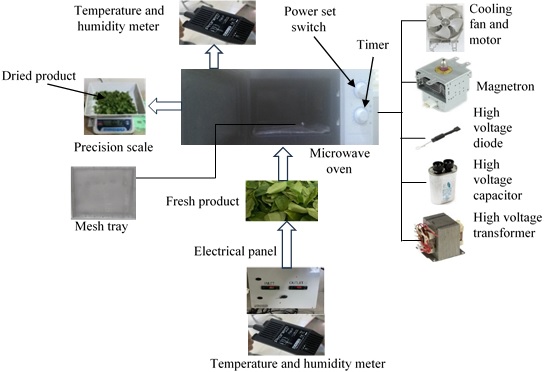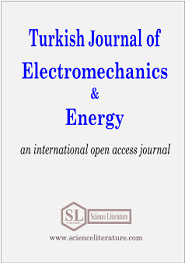
Microwave effect on drying behavior and quality parameters of green tea leaves
Abstract
This study aims to investigate the effect of microwave on drying behavior and quality parameters of green tea leaves experimentally and to perform mathematical modeling of microwave drying of green tea leaves. For this purpose, experiments were performed at 100 W, 300 W, 600 W and 800 W microwave powers and the mass loss and drying time were measured. Depending on the measured parameters, dimensionless moisture ratio, moisture content, mass shrinkage ratio, and drying rate were estimated. The quality parameters such as water extract, cellulose, total ash, caffeine, and total polyphenol were also determined. Furthermore, the best thin layer drying curve equation was obtained by using mathematical modeling for microwave drying of green tea leaves. As a result, improved Midilli-Kucuk model was determined as the best drying curve equation that describes the drying behavior of green tea leaves at all microwave power levels adopted. Also, it was determined that the highest water extract is 35.44% at 300 W, the highest caffeine is 1.93% at 800 W, the highest polyphenol is 11.20% at 300 W, the lowest total ash is 5.95% at 800 W, and the lowest cellulose is 17.79% at 300 W. It was observed that green tea leaves retain their natural color in its best at 800 W.
Full Text:
PDFReferences
A. Midilli, H. Kucuk, and Z. Yapar, “A new model for single-layer drying,” Drying Technology, 20(7), pp. 1503-1513, 2002.
E. Demirhan, and B. Özbek, “Microwave-drying characteristics of basil,” Journal of Food Processing and Preservation, 34(3), pp. 476-494, 2010.
A. R. Al-Hilphy, M. Gavahian, F. J. Barba, J. M. Lorenzo, Z. M. Al-Shalah, and D. K. Verma, “Drying of sliced tomato (Lycopersicon esculentum L.) by a novel halogen dryer: Effects of drying temperature on physical properties, drying kinetics, and energy consumption,” Journal of Food Process Engineering, vol. 44, e13624, 2020.
B, Llavata, J. V. García-Perez, S. Simal, and J. A. Carcel, “Innovative pre-treatments to enhance food drying: a current review,” Current Opinion in Food Science, vol. 35, pp. 20-26, 2020.
B. Alaei, N. Dibagar, R. A. Chayjan, M. Kaveh, and E. Taghinezhad, “The effect of short and medium infrared radiation on some drying and quality characteristics of quince slices under vacuum condition,” Quality Assurance and Safety of Crops & Foods, 10(4), pp. 371-381, 2018.
T. Kudra, and A. S. Mujumdar, Advanced drying technologies. (2nd ed.). CRC Press, New York, USA, 2009.
M. Köse, “Manufacturing and experimental determination of drying performance of swirling flow fluidized bed microwave green tea dryer,” M.Sc. Dissertation, Recep Tayyip Erdoğan University, Rize, Türkiye, 2022.
Ö. Okur, H. Kucuk, and A. Midilli, “Triple-effect new generation drying technique,” Innovative Food Science and Emerging Technologies, vol. 89, p.103489, 2023.
Y. Soysal, S. Öztekin, and Ö. Eren, “Microwave drying of parsley: modelling, kinetics, and energy aspects,” Biosystems Engineering, 93(4), pp. 403-413, 2006.
J. M. Lechtanska, J. Szadzinska, and S. J. Kowalski, “Microwave- and infrared-assisted convective drying of green pepper: quality and energy considerations,” Chemical Engineering and Processing, vol. 98, pp. 155-164, 2015.
E. T. Thostenson, T. W. Chou, “Microwave processing: fundamentals and applications,” Composites Part A: Applied Science and Manufacturing, vol. 30, pp. 1055-1071, 1999.
B. Özbek, and G. Dadali, “Thin layer drying characteristics and modeling of mint leaves undergoing microwave treatment,” Journal of Food Engineering, 83(4), pp. 541-549, 2007.
M. Al-Harahsheh, A. H. Al-Muhtaseb, T. R. A. Magee, “Microwave drying kinetics of tomato pomace: effect of osmotic dehydration,” Chemical Engineering and Processing: Process Intensification, 48(1), pp. 524-531, 2009.
J. Dong, X. Ma, Z. Fu, and Y. Guo, “Effects of microwave drying on the contents of functional constituents of Eucommia ulmoides flower tea,” Industrial Crops and Products, 34(1), pp. 1102-1110, 2011.
R. Vadivambal, D. S. Jayas, “Changes in quality of microwave-treated agricultural products-a review,” Biosystems Engineering, 98(1), pp. 1-16, 2007.
Y. Huang, J. Sheng, F. Yang, and Q. H. Hu, “Effect of enzyme inactivation by microwave and oven heating on preservation quality of green tea,” Journal of Food Engineering, 78(2), pp. 687-692, 2007.
İ. Alibaş, “Microwave drying of grapevine (Vitis vinifera L.) leaves and determination of some quality parameters,” Journal of Agricultural Sciences, vol. 18, pp. 43-53, 2012.
M. F. Arikan, Z. Ayhan, Y. Soysal, and O. Esturk, “Drying characteristics and quality parameters of microwave-dried grated carrots,” Food and Bioprocess Technology, vol.5, pp. 3217-29, 2012.
M. Şimşek, “Experimental investigation and mathematical modeling of microwave drying behavior of some vegetables and fruits,” M.Sc. Dissertation, Recep Tayyip Erdoğan University, Rize, Türkiye, 2018.
M. Ganesapillai, I. Regupathi, and T. Murugesan, “An empirical model for the estimation of moisture ratio during microwave drying of plaster of paris,” Drying Technology, 26(7), pp. 963-978, 2008.
A. Sarimeseli, “Microwave drying characteristics of coriander (Coriandrum sativum L.) leaves,” Energy Conversion and Management, 52(2), pp. 1449-1453, 2011.
H. Kucuk, A. Midilli, A. Kilic, and I. Dincer, “A review on thin-layer drying-curve equations,” Drying Technology, 32(7), pp. 757-773, 2014.
A. Midilli and H. Kucuk, “Mathematical modeling of thin layer drying of pistachio by using solar energy,” Energy Conversion and Management, vol. 44, pp. 1111-1122, 2003.
H. Çakmak, N. Bozdoğan, G. M. Turkut, S. Kumcuoğlu, and Ş. Tavman, “Evaluation of drying kinetics of arbutus unedol. fruit and determination of quality characteristics,” The Journal of Food, 41(4), pp. 227-234, 2016.
M. Şimşek, H. Kucuk, A. Midilli, “Experimental investigation and mathematical modeling of microwave thin layer drying behavior of apricot, kiwi and mint leaves,” Recep Tayyip Erdogan University Journal of Science and Engineering, 2(2), pp. 13-35, 2021.
A. Midilli, H. Olgun, and T. Ayhan, “Experimental studies on mushroom and pollen drying,” International Journal of Energy Research, vol. 23, pp. 1143-1152, 1999.
H. Küçük, U. Akbulut, and A. Midilli, “Single-layer drying modeling of pumpkin (Cucurbita Maxima),” Turkish Journal of Electromechanics and Energy, 7(3), pp. 110-119, 2022.
A. Midilli, and H. Kucuk, “Development of a new curve equation representing thin layer drying process,” Energy Sources, Part A: Recovery, Utilization, and Environmental Effects, 45(4), pp. 9717–9730, 2023.
Turkish Food Codex, 2015. Available: https://www.resmigazete.gov.tr/eskiler/2015/06/20150617-4.htm [Accessed 20 July 2023].
A. Thea, E. Lloret, A. Maria, A. L. Brumovsky, and M. E. Schmalko, “Differences in quality parameters between types of commercial tea from Argentina,” International Journal of Food Studies, vol. 1, pp. 168 -178, 2012.
M. A. Turan, M. Balcı, M. B. Taşkın, Z. Kalcıoğlu, M. R. Soba, N. Müezzinoğlu, E. C. Kaya, P. Özer, A. Kabaoğlu, and S. Taban, “The content of water extract, total ash, total polyphenol, caffeine and crude cellulose of tea plant (Camellia sinensis L.) old leaves grown in the East Black Sea Region,” Soil Water Journal, 5(2), pp. 52-58, 2016.
A. Y. Yashin, B. V. Nemzer, E. Combet, and Y. I. Yashin, “Determination of the Chemical Composition of Tea by Chromatographic Methods: A Review,” Journal of Food Research, 4(3), pp. 56, 2015.
URN: https://sloi.org/urn:sl:tjoee91300
Copyright (c) 2024 Turkish Journal of Electromechanics and Energy

This work is licensed under a Creative Commons Attribution-NonCommercial 4.0 International License.

 Indexed in:
Indexed in:
















